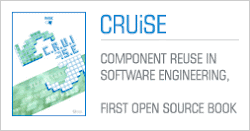 Yesterday, (May 25, 2008) started the main reuse conference around the world. The initial day started with the Doctoral Symposium. In this symposium, coordinated by Greg Kulczycki (Virginia Tech) with the participation of Bill Frakes (Virginia Tech) and I, three Ph.D. students received feedback from their research related to quality improvement, formal methods and agents. The main issue in this symposium was the lack of the big picture during the presentations. The students had difficulties to explain clearly the main points: the problem, the state-of-the-art, and their proposal. However, I believe that the feedback received will be useful.
Yesterday, (May 25, 2008) started the main reuse conference around the world. The initial day started with the Doctoral Symposium. In this symposium, coordinated by Greg Kulczycki (Virginia Tech) with the participation of Bill Frakes (Virginia Tech) and I, three Ph.D. students received feedback from their research related to quality improvement, formal methods and agents. The main issue in this symposium was the lack of the big picture during the presentations. The students had difficulties to explain clearly the main points: the problem, the state-of-the-art, and their proposal. However, I believe that the feedback received will be useful. In the afternoon, we had the IV RESAFE: International Workshop on Software Reuse and Safety coordinated by Bill Frakes and Jonh Favaro. In this workshop, Bill, John, Dirk Muthig, Greg and I had good discussions about contracts, certification, safety, reliability. John presented his experience with automobile projects in Europe while Bill and Greg discussed their point of views related to Therac accident and contracts respectively. I explained a little about experience with component certification and Dirk showed some directions related to the KobrA approach. After the conference, Bill and John will write a summary about the workshop. By the way, the day was good to meet other researchers such as Ruben-Prieto and Wayne Lim who was presenting his awarded tutorial at RiSS in the ICSR.








